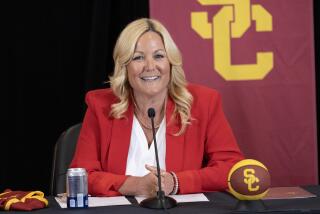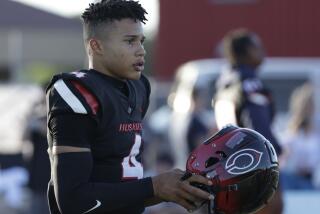Most Pass in NCAA Report
- Share via
The NCAA’s new method for gauging how athletes perform in the classroom produced its first results Monday with a report that gave a passing grade to most teams across the nation but showed that others -- including some bowl-bound football squads -- continue to falter.
The graduation success rate, or GSR, is part of a sweeping reform by which the NCAA hopes to make teams accountable for more than wins and losses.
This effort had initially relied on a federal standard that many coaches said unfairly penalized teams for athletes who transfer to other schools or leave early to turn professional.
Calling the federal method “helpful but inaccurate,” NCAA President Myles Brand characterized the GSR as “a very important shift in the way we calculate graduation rates.”
The most recent federal data showed a rate of 62% for all Division I college athletes. Using the GSR, that number rose to 76%.
Despite this increase, the Knight Commission on Intercollegiate Athletics noted that of the 56 football teams in major-college bowl games, 11 graduated less than 50% of their players.
That included Rose Bowl-bound Texas at 40% and Georgia, headed for the Sugar Bowl, at 45%.
“Regardless of the standard used for graduation rates, the data show that some institutions still have significant problems,” said Clifton R. Wharton Jr., the commission’s vice chairman and president emeritus of Michigan State University.
Teams with graduation rates above 90% included Navy, Notre Dame and Northwestern. UCLA had a rate of 63%; USC had a rate of 55%.
Under the previous federal standard, if USC football players Reggie Bush, LenDale White and Darnell Bing chose to leave school early for the NFL draft in the spring, all three would count as failures, even if they were in good academic standing and returned to complete their studies.
Scott Ware, who transferred from junior college, would not count in the Trojans’ favor, even if he graduated this spring.
The GSR accounts for such situations and will be used in conjunction with another standard, the academic progress rate, or APR, which measures performance in semester-by-semester snapshots.
Teams with substandard APR scores could suffer penalties such as loss of scholarships.
The GSR, with its more accurate and longer-term measurement, will carry harsher punishments, including banishment from postseason play and loss of NCAA membership. But such actions will not begin immediately.
“This is a first-year dry run to make sure everyone understands the methodology,” Brand said.
The initial GSR report covered freshman classes that entered school from 1995 to 1998 and were given six years to graduate. Thus, the numbers are somewhat dated and reflect a time before the NCAA’s reform efforts began in earnest.
The change in formulas means that USC’s football team rose from a 50% federal rate to 55% under the GSR for that period. The basketball team’s score rose from 27% to 44%.
The UCLA football team went from 57% to 63%, the basketball team from 31% to 38%.
“The changes they have made are the right thing and totally fair,” UCLA basketball Coach Ben Howland said. “It shouldn’t hurt you [if a player turns pro], because that’s the reality.”
The NCAA said it would release aggregate rates for schools in January.
Not all scores will increase under the new method. Teams that have relied on transfer students -- ignored by federal standards -- will see their rates dip if those athletes fail academically.
The new numbers also might cause the association to adjust its thinking about classwork. At present, teams are judged to be performing satisfactorily with a 50% graduation rate.
If the GSR numbers continue to come in higher, the cutoff rate might be raised, officials said.
More to Read
Go beyond the scoreboard
Get the latest on L.A.'s teams in the daily Sports Report newsletter.
You may occasionally receive promotional content from the Los Angeles Times.











